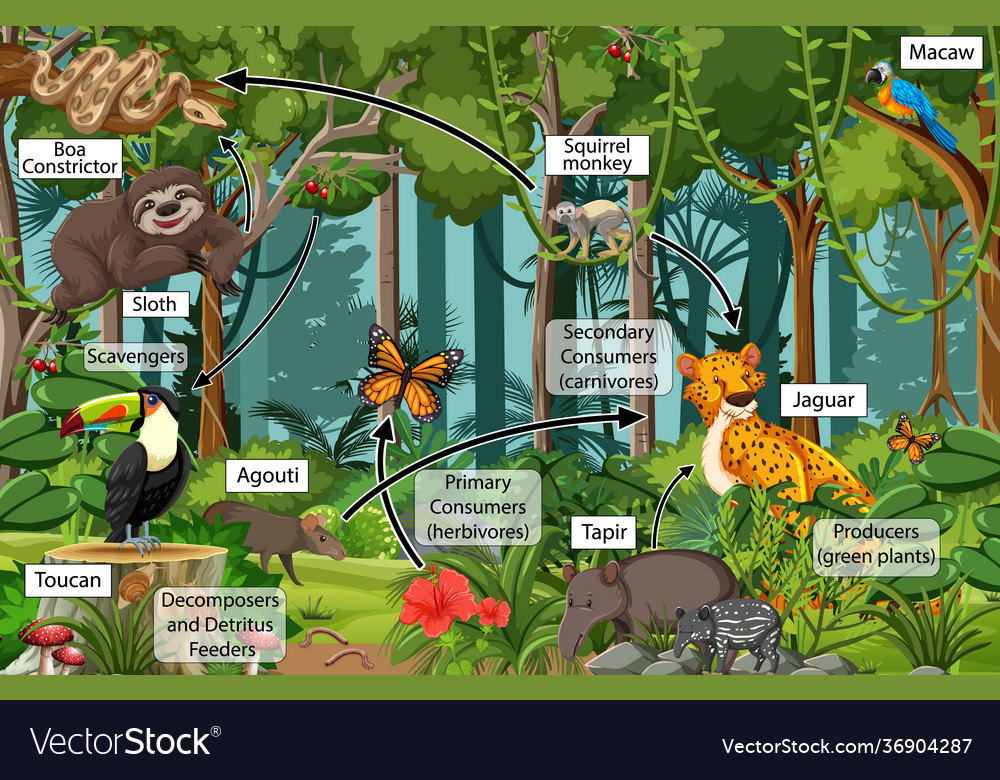The rainforest is a mesmerizing ecosystem teeming with life and biodiversity. One of the most fascinating aspects of the rainforest is the intricate food chain that sustains the diverse array of animals that call this environment home. The rainforest food chain is a complex web of interdependence, where each organism plays a crucial role in the balance of the ecosystem.
Layers of the Rainforest
The rainforest is divided into distinct layers: the emergent layer, canopy, understory, and forest floor. Each layer supports a unique variety of plant and animal life, contributing to the complexity of the rainforest food chain. This multi-layered ecosystem provides diverse habitats for a wide range of species to thrive.
Producers: The Foundation of the Food Chain
At the base of the rainforest food chain are the producers, primarily consisting of plants, trees, and other vegetation. These producers harness the energy from the sun through photosynthesis, converting it into food for themselves and other organisms. The lush greenery of the rainforest provides an abundant source of sustenance for the herbivores that feed on these plants.

Credit: www.vecteezy.com
Primary Consumers: Herbivorous Delights
Feeding on the producers are the primary consumers, also known as herbivores. These animals, ranging from insects to large mammals, rely on the vegetation for their nourishment. In the rainforest, primary consumers include sloths, tapirs, monkeys, insects, and many other herbivorous species that play a crucial role in shaping the ecosystem.
Secondary Consumers: Carnivorous Predators
The next level of the food chain consists of the secondary consumers, which are the carnivorous predators that feed on the herbivores. This tier includes animals such as jaguars, snakes, eagles, and other predators that keep the herbivore populations in check, preventing overgrazing and maintaining a balanced ecosystem.
Tertiary Consumers: Apex Predators
At the top of the rainforest food chain are the tertiary consumers, or apex predators, which have very few natural predators of their own. These animals, such as big cats and large birds of prey, exert a top-down control on the population of other species in the ecosystem, contributing to the regulation of the entire food web.
Decomposers: Nature’s Recyclers
Completing the cycle are the decomposers, such as fungi, bacteria, and insects, which break down the remains of plants and animals, returning essential nutrients to the soil and facilitating the growth of new vegetation. This crucial role played by decomposers ensures the continuation of the food chain and the sustainability of the rainforest ecosystem.
Human Impact on the Rainforest Food Chain
Unfortunately, human activities such as deforestation, poaching, and climate change have significantly disrupted the delicate balance of the rainforest food chain. The loss of habitat and the decline of certain species have had profound effects on the intricate web of interdependence that sustains the rainforest ecosystem.
Preserving the Rainforest Food Chain
Conservation efforts and sustainable practices are essential for protecting the rainforest food chain and preserving the biodiversity of this invaluable ecosystem. By supporting initiatives that promote responsible land use, wildlife protection, and the sustainable harvest of forest resources, we can help safeguard the intricate food chain of rainforest animals for future generations to marvel at and appreciate.
In conclusion, the food chain of rainforest animals exemplifies the interconnectedness of all living organisms within this extraordinary ecosystem. From the producers at the bottom of the chain to the apex predators at the top, each species plays a vital role in maintaining the equilibrium of the rainforest. By understanding and respecting the complexities of the rainforest food chain, we can work towards ensuring the continued survival and prosperity of this remarkable natural environment.
Frequently Asked Questions On Rainforest Animals Food Chain
What Animals Are A Part Of The Rainforest Food Chain?
The rainforest food chain includes animals such as jaguars, sloths, monkeys, and toucans.
How Do Animals In The Rainforest Find Their Food?
Animals in the rainforest find their food through hunting, foraging, and feeding on plant matter.
What Role Do Insects Play In The Rainforest Food Chain?
Insects in the rainforest food chain act as pollinators, decomposers, and a food source for other animals.
Why Is The Rainforest Food Chain Important For Ecosystem Balance?
The rainforest food chain maintains a balance by controlling population levels and ensuring resource distribution.

Leave a Reply